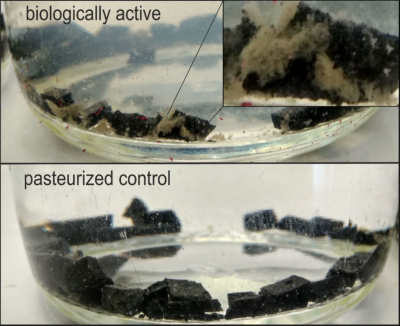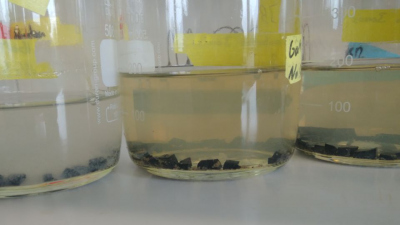- Home
- Discover
- Media Releases
- Media Releases 2022
- Asphaltablagerung
Laboratory experiment identifies asphalt as a source for non-degradable carbon and sulfur compounds in the ocean
“Half of the oil in the oceans originates from natural seeps. The other half comes from man-made pollutants. When we understand how long it takes for the toxins in the oil to degrade and be transformed, then we can learn from nature,” explains first author Jonas Brünjes. The aim of the team of researchers from MARUM and the University of Oldenburg was to identify the water-soluble components of the oil and their microbial degradation in the deep sea. When oil is released as a result of human activity, the amounts are often so great that the ecosystem is severely contaminated and overloaded. But at natural seeps, the amounts released are smaller, and the time scale much greater, so that the ecosystem in the deep sea is more capabale to break it down. In a laboratory experiment, Brünjes and his colleagues tested exactly what happens during this process.
They focused primarily on heavy oil, or asphalt. The existence of an asphalt volcano was first described in the Gulf of Mexico with the discovery of the Chapopote Asphalt Volcano in the southern Gulf, and this is where the samples were obtained for their laboratory experiment. They were retrieved during an expedition of the RV METEOR in 2015.
For the experiment, material was immersed from a water depth of about 2,500 meters and then stored in artificial seawater for four weeks. Artificial seawater was used because it does not contain additional organic carbon sources, but has all the nutrients needed for microbial life. The laboratory experiment revealed that the asphalt was used as the sole carbon source. “In the laboratory, the bacterial communities that live at these kinds of naturally toxic sites were able to colonize the asphalt. They form the base of the food web for higher organisms in the deep sea," summarizes Dr. Florence Schubotz. She was the initiator of the project and also collected the samples.
The oil that seeps from the asphalt volcanoes is complex and contains compounds that are highly toxic for humans. In the water-soluble fraction of the experiment, non-degradable sulfur compounds were found as well as black carbon, which is known to persist in sea water for thousands of years. Until now, the only known source for these compounds was the soot that results, for example, from forest fires.
This study forms the basis for further investigations, particularly on the element cycles in the deep sea that are not yet completely understood. In addition to the purely quantitative approach of quantifying mass budgets, there is also a qualitative aspect to studying the fate of hard-to-degrade material in the deep sea.
The aim of the scientists is to learn from nature. This is why the degradation of heavy oil, among other compounds, is being studied at MARUM within the Cluster of Excellence “The Ocean Floor – Earth’s Uncharted Interface” under anaerobic and aerobic conditions. Jonas Brünjes has dealt with the latter experimentally in his dissertation.
Contact:
Jonas Brünjes
MARUM – Center for Marine Environmental Sciences
University of Bremen
Email: [Bitte aktivieren Sie Javascript]
Dr. Florence Schubotz
MARUM – Center for Marine Environmental Sciences
University of Bremen
Telephone: 0421 – 218 65724
Email: [Bitte aktivieren Sie Javascript]
MARUM produces fundamental scientific knowledge about the role of the ocean and the seafloor in the total Earth system. The dynamics of the oceans and the seabed significantly impact the entire Earth system through the interaction of geological, physical, biological and chemical processes. These influence both the climate and the global carbon cycle, resulting in the creation of unique biological systems. MARUM is committed to fundamental and unbiased research in the interests of society, the marine environment, and in accordance with the sustainability goals of the United Nations. It publishes its quality-assured scientific data to make it publicly available. MARUM informs the public about new discoveries in the marine environment and provides practical knowledge through its dialogue with society. MARUM cooperation with companies and industrial partners is carried out in accordance with its goal of protecting the marine environment.

Jonas Brünjes, Michael Seidel, Thorsten Dittmar, Jutta Niggemann, and Florence Schubotz: Natural Asphalt Seeps Are Potential Sources for Recalcitrant Oceanic Dissolved Organic Sulfur and Dissolved Black Carbon. Environmental Science & Technology Article ASAP. DOI: 10.1021/acs.est.2c01123




